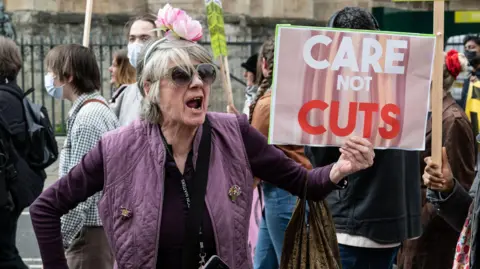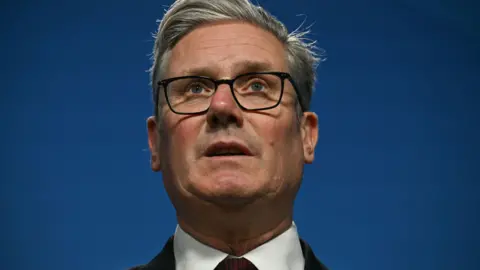What do UK welfare reforms mean for Scotland?
 Getty Images
Getty ImagesThe UK government has confirmed it will scale back its planned welfare reforms in a bid to fight off a rebellion by backbench Labour MPs.
A third of the Scottish group of Labour MPs were among the 120-odd who signed an amendment calling for the changes to be scrapped.
But with much of social security devolved to Holyrood, what do the concessions now made by Sir Keir Starmer mean in Scotland?
Details are still being confirmed ahead of votes at Westminster next Tuesday.
But the headline is that instead of tightening who is eligible for certain disability and sickness benefits straight away, planned cuts will only hit future claimants.
Scotland has its own devolved social security system, which puts limits on the direct impacts for people here.
Universal Credit still applies across the UK, so reforms to that will affect Scottish claimants. Or, to be exact, future claimants of the health element.
Anyone currently in receipt of this will continue to get it, but anyone starting a claim in future may be assessed more rigorously.
But the same cannot be said of the other major target of the reforms, the Personal Independence Payment (Pip).
 PA
PAAs of this summer, everyone who was on Pip is due to have been transferred to the Scottish equivalent, the Adult Disability Payment (ADP).
There are still some outstanding questions. Citizens' Advice Scotland has questioned whether ADP will have the same "passporting" capacity as Pip, where eligibility for one benefit can provide access to others at a UK level.
Hopefully, this is the kind of detail which will become clearer once legislation is amended at Westminster and as backroom officials get their heads together to iron out how things will work in practice.
Social Justice Secretary Shirley-Anne Somerville has been clear that the Scottish government "will not follow Labour's lead on any of these changes".
We essentially have two governments moving in different directions when it comes to social security.
Regardless of the latest U-turn, the UK government is still keen to get a grip on welfare spending in light of a forecast £30bn increase in the cost of working-age health-related benefits.
The watchword has long been about getting people back into work and keeping budgets from ballooning in future years.
Meanwhile, the Scottish government prides itself on taking a more generous approach.
It has set up new offerings like the Scottish Child Payment, currently set at £27.15 per week for eligible families.
Government modelling suggests that policy alone will keep 40,000 children out of relative poverty this year.
How much does Scotland spend on social security?
Ministers have also uprated benefits by inflation each year - including the new winter fuel payment, allowing them to trumpet that it is a more generous offering than that available down south, even if the difference is only £3.
Social security thus accounts for an increasingly large share of the Scottish government's budget.
The Scottish Fiscal Commission says spending on it was £6.1bn in 2024-25.
Their latest forecast for next year is £7.7bn, and the figure is due to pass £9bn by 2029-30.
The Adult Disability Payment makes up the lion's share of that figure, with the cost set to hit £5bn by the end of the decade.
That's almost ten times more than the Scottish Child Payment (£517m in 2029-30), and almost thirty times more than the devolved winter fuel payment (£174m) - benefits which politicians spend far more time talking about.
It's a reminder that there can be a big difference between the political importance of a policy and the financial weight of it.
 Getty Images
Getty ImagesThe key question is how this is all going to be paid for.
At the end of the day John Swinney has the same problem as Sir Keir Starmer - budgets are finite, and costs are rising.
Spending on social security in Scotland is already £1.2bn higher than the block grant which comes from Westminster. The gap is forecast to grow to £2bn by 2029-30.
That's £2bn that the Scottish government has to find elsewhere in its budget. Or raise from taxation.
And if the UK government does ultimately reduce its welfare spending, that will in turn reduce the amount of funding flowing to Holyrood and widen the financial gap.
Sir Keir's original plan was to save £5bn by 2030. Some analysis is suggesting the cuts may be closer to £3bn now.
Scottish government officials are already scratching their heads about what this means for their own budget.
Allocations have fluctuated quite a bit as policy has shifted at Westminster, so it's hard to predict what the figures will be until the chancellor announces them.
But if we remain in a position where the UK government is seeking to cut its welfare bill while the Scottish government's one increases, it's obvious that the financial gulf is going to grow.
The SNP administration has already leaned on its powers over income tax to fund some of this extra spending, with ministers again proud to talk about a more "progressive" system that asks those with the broadest shoulders to pay more to support public services.
But Finance Secretary Shona Robison has been clear that they can't keep going back to the well on that front. Further tax rises have already been ruled out for the rest of this parliamentary term.
So they have embarked on a programme of public service reform, which includes targets to reduce the public sector workforce by 0.5% per year and to cut the cost of running government and public bodies.
A previous commitment to universal entitlements has also fallen by the wayside.
 PA Media
PA MediaWhen setting up the Scottish version of the winter fuel payments, ministers had insisted on a universal approach - at the very least a payment to all households, if not all individual pensioners.
But they have now decided to copy the UK government's model of automatically clawing back payments from better-off households, and targeting funds at those most in need.
At the end of the day, all of this feeds into the politics of next year's Holyrood election, with the SNP and Labour already locked in a fierce battle for a fairly similar chunk of the electorate.
John Swinney built his efforts to turn around the SNP's fortunes after last year's general election drubbing on a pledge to mitigate the two-child cap on some UK benefit payments.
Again this is something which has a much bigger political impact than a financial one. The Scottish Fiscal Commission (SFC), which provides independent economic forecasts, reckons this will cost about £200m a year by 2030.
But the first minister has not missed an opportunity to hammer home his message that the SNP will be more generous to Scottish voters than Labour is being at Westminster.
What will this mean at the polls?
His party's campaigning is based very heavily on its record of big-state interventions and universal entitlements.
A leaflet they circulated during last year's election campaign listing the SNP's achievements in office gave prominent place to the Scottish Child Payment, alongside free tuition; free personal care; free prescriptions; free bus travel; free school lunches; free baby boxes and free childcare.
Labour, meanwhile, have majored on responsible stewardship of the public finances in their UK campaigns.
And Scottish leader Anas Sarwar is not promising a tax-and-spend approach at Holyrood.
He says he'd ideally like to cut the tax burden, while maintaining spending on public services by growing the economy.
Ultimately these are two parties which face similar problems in government - tight budgets, weak growth and spiralling costs.
The answers they provide - and the extent to which voters trust them to deliver on them - are going to play a critical role in next May's election.
